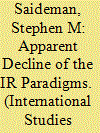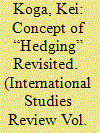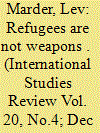|
|
|
Sort Order |
|
|
|
Items / Page
|
|
|
|
|
|
|
| Srl | Item |
| 1 |
ID:
163756


|
|
|
|
|
| Summary/Abstract |
Have the major international relations paradigms declined as much as has been asserted? Some scholars view paradigmatic theory and theory in general as on the decline as hypothesis-testing now apparently dominates published research. Such scholars argue that professionalization provides disincentives to theorize. This article demonstrates that these arguments are based on perceptions rather than on the data, on speculation about what professionalization incentivizes and how that influences research production. This article examines several datasets to consider these assertions. The article addresses what is being published, how scholars see themselves and the field, and what is being cited. Because scholars are publishing more articles compared to in the 1980s, the changes that some scholars have observed about the decline of certain approaches and the rise of others are relative and not absolute. A closer examination of the data reveals that what is perceived to be the normal pattern of theoretical output was an outlier in the mid-1990s and that pure theory development has always been a niche enterprise. To explain the trends, rather than stressing the impact of professionalization of the discipline, the article proposes an alternative process that focuses less on structure and more on agency. Social movements aimed to increase the publication of diverse theories and methodologies may have simply been effective: new journals are publishing more and more diverse articles, fostering a wider range of work. The article concludes by exploring the implications of the patterns of theory development in published IR research.
|
|
|
|
|
|
|
|
|
|
|
|
|
|
|
|
| 2 |
ID:
163750


|
|
|
|
|
| Summary/Abstract |
How does climate change affect the risk and dynamics of violent conflict? Existing research shows that climate change can increase the risk of violent conflict and significantly alter the dynamics of existing conflicts. Less is known about the exact mechanisms through which climate change affects violent conflict. In this article, we address this lacuna in light of the first systematic review of both quantitative and qualitative scholarship. Through an analysis of forty-three peer-reviewed articles on climate-related environmental change and violent conflict in East Africa published 1989–2016, we evaluate to what extent the literature provides coherent explanations that identify relevant mechanisms, actors, and outcomes. In addition, we discuss the expected temporal and spatial distribution of violence and the confounding political factors implied in the literature. Against this background, we offer a number of suggestions for how future climate-conflict research can theorize and explore mechanisms. Future research should distinguish between explanations that focus on causes and dynamics of climate-related violent conflict, theoretically motivate when and where violence is most likely to occur, systematically examine the role of state policies and intervention, and explore the implications of each explanation at the microlevel.
|
|
|
|
|
|
|
|
|
|
|
|
|
|
|
|
| 3 |
ID:
163754


|
|
|
|
|
| Summary/Abstract |
This article argues that the concept of “hedging” should be understood in the context of the “balancing-bandwagoning” spectrum within the “balance of power” theory, in which hedging is located between balancing and bandwagoning as the state's third strategic choice. Although polarity— unipolar, bipolar, and multipolar—largely determines the likelihood of hedging behavior, during a period of power shift, strategic uncertainty emerges. States, particularly secondary powers, attempt to calculate the risk of balancing, bandwagoning, and hedging, adopting an optimal strategy. To identify states’ strategic behavior, it is important to first examine their economic and military capabilities, and if these indicators are not decisive enough to identify balancing, bandwagoning, or hedging behavior, diplomatic factors should be taken into account, although those are a relatively weaker indicator.
The use of this conceptual framework reveals that Japan's foreign policy behavior has not involved “hedging” vis-à-vis China; instead, Japan's behavior is consistently associated with “balancing” against the risks of China's rise. In addition, while Japan's behavior vis-à-vis the United States is considered to be bandwagoning, Japan made political efforts to strengthen its own military capabilities—internal balancing—which began in the 2010s when Japan relaxed its political constraints on use of its military. This behavior also aimed both to illustrate Japan's efforts related to alliance burden-sharing and to enhance its external balancing with the United States. Yet, the periods from 1997 to 2005 and from 2010 on represent an aberration because Japan engaged one type of hedging—security hedging—vis-à-vis the risk of US commitment reduction to East Asia. In this sense, while concurring with the realists’ argument that Japan's current behavior is characterized as balancing, the argument differs from that of realists who believe that Japan's policy shift to balancing toward China only began with China's rise in the late 2000s or 2010s.
|
|
|
|
|
|
|
|
|
|
|
|
|
|
|
|
| 4 |
ID:
163753


|
|
|
|
|
| Summary/Abstract |
One of the most-studied issues regarding the role of natural resources in development is the so-called “resource curse”: the paradoxical (and contested) situation in which a state with abundant resources has low rates of economic growth per capita, high levels of income inequality, low levels of democracy, high gender inequality, and high levels of domestic and international conflicts surrounding resources. Although the term seems to imply that the curse can apply to all resources, most research by political scientists, as well as by economists and other social scientists, examines the role of oil and hard minerals and omits many resources, including renewable energy resources. We argue that many of the causal mechanisms behind the curse, when it does manifest, hold for water-abundant states which have sufficient resources to create large hydroelectric projects. Drawing on illustrative examples of hydroelectric projects around the world, we demonstrate sufficient, albeit preliminary, evidence that most aspects of the resource curse literature apply to hydroelectric projects, at least in some states, and thus suggest the curse literature should be expanded to include water-abundance. Additionally, we add a new factor—fluctuating fuel supply—which could be an important variable for other resources as well. We conclude with suggestions for developing a research agenda and discuss policies to reduce the negative effects of resource curse.
|
|
|
|
|
|
|
|
|
|
|
|
|
|
|
|
| 5 |
ID:
163752


|
|
|
|
|
| Summary/Abstract |
The quality of social science inquiry examining terrorism, insurgency, and nonviolent civil resistance has progressed rapidly in recent years. One reason for this advancement is the emergence of new datasets and the subsequent application of quantitative methods to the analysis of asymmetric political conflict between states and nonstate actors. Despite rapid development within the research paradigm, the use of new data has coincided with several methodological and conceptual challenges. This inquiry employs insights from qualitative social science methodology and organizational sociology to highlight and propose solutions to three shortcomings found in recent quantitative analyses of asymmetric conflict. The first problem arises from scholars’ proclivity to ask research questions based on easily accessible categories of data rather than on theoretically significant puzzles in the literature. The second pitfall concerns limitations and “conceptual stretching” associated with static, nominal variables constructed to enable statistical inference. Finally, the third class of research obstacles arises from selection bias caused by underreporting of data. Each of these methodological problems potentially undermines theoretical claims made in recent work on insurgent organizations, terrorism, civil war, and nonviolent resistance.
|
|
|
|
|
|
|
|
|
|
|
|
|
|
|
|
| 6 |
ID:
163751


|
|
|
|
|
| Summary/Abstract |
In 2010, Kelly Greenhill published her highly acclaimed book Weapons of Mass Migration: Forced Displacement, Coercion, and Foreign Policy. In this article, I focus on the uses and implications of Greenhill's theory and specifically the metaphor Greenhill uses in place of “coercive engineered migration”—“weapons of mass migration.” The metaphor unmistakably links refugees to “weapons of mass destruction.” This should not be dismissed as just a phrase, considering that metaphors are one of the fundamental elements of thinking in international relations. Inquiring into the utility of the metaphor, I argue that associating refugees with weapons (1) weaponizes the metaphor against refugees, (2) frames the problem and possible solutions in a restrictive, securitized way that should be questioned, and (3) even undermines one of four policy options Greenhill herself proposes. After highlighting the merits of Greenhill's analysis and its embrace among far-right ideologues and conspiracy theorists, using Paul Chilton and George Lakoff's delineation of three utilities of metaphors in foreign policy, I analyze the “weapons of mass migration” metaphor. The article ends with a discussion of possible ways to mitigate the metaphor's effects and discusses alternative metaphors.
|
|
|
|
|
|
|
|
|
|
|
|
|
|
|
|
| 7 |
ID:
163755


|
|
|
|
|
| Summary/Abstract |
What factors determine how China attempts to terminate armed conflict? This article derives from the war termination literature three factors that impact the ability of disputants to resolve conflicts: approach to wartime diplomacy, views on escalation, and receptiveness to mediation. I then evaluate China’s attempts to bring conflict to a close according to these three factors in the Korean War, Sino-Indian War, and Sino-Vietnamese War. I argue that China tends to entertain talks only with weaker opponents, rely on heavy escalation to bring about peace, and leverage outside parties less as empowered mediators and more as an additional source of pressure on its enemies. A subsequent analysis of authoritative Chinese strategic writings reveal that these patterns have been imbued in contemporary thought and, therefore, are likely to persist in future flashpoints. My findings add a new dimension to the war termination literature and have policy implications for regional peace and stability.
|
|
|
|
|
|
|
|
|
|
|
|
|
|
|
|
|
|
|
|
|